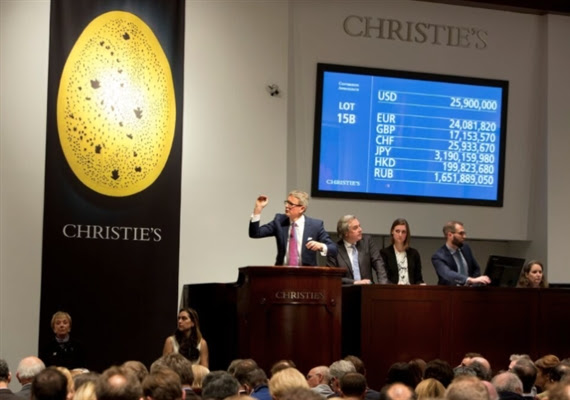The Italian Art sale at Christie's in 2015
Though auction houses and dealers welcomed the change, they had initially petitioned to extend the original 50-year cut off for licences by 100 years, not 20. Speaking in The Art Newspaper, Benedict Tomlinson, director of Robilant + Voena commented: “The 20-year extension seems arbitrary, why not extend it to Old Masters?” also questioning what would happen in a few years when Fontanas were once again old enough to acquire a licence.
So have these changes had an impact? While it should, technically, be easier to export art, the change was not reflected in dedicated sales of Italian art at either Christie’s or Sotheby’s in 2017, both of which featured fewer lots than their 2016 competitors.
Germany
When Germany elected to change its import and export laws in June 2016, it was met with uproar from the country’s art professionals, who complained that the new measures risked excessive expense and bureaucratic process.
The change in legislation set both value and age criteria for exports within and outside of the EU, requiring state approval for works under 50 years old valued over €150,000 ($170,000) outside of the EU, and under 75 years old with a value of over €300,000 ($340,000) within the EU.
Germany’s Culture Minister Monika Grütters defended the new Cultural Heritage Protection Law, emphasizing its noble ambitions of halting the illegal trade of looted antiques, and preventing culturally significant artworks from leaving the country.
Though Grütters’ legislation may have had a positive effect on the trade of illegal goods, a positive impact on cultural heritage seemed less certain. Under the new laws, works loaned to German museums are subject to a special status as culturally protected objects — a change that lead many high-profile collectors and artists, including Gerhard Richter and Georg Baselitz, to threaten the withdrawal of many works on display.
While Germany may have founded the world’s first art fair, it’s current ability to vy for a position as Europe’s market leader is weak; according to TEFAF’s 2016 report, the country held just 2% of the world’s global art market share.
Brazil
In the last decade, points of growth have brought an influx of galleries, fairs and creative projects to Brazil. Despite this interest, however, the country’s taxes on cultural goods remain some of the highest in the world, with a sales tax of between 50 and 60%, compared to 8.9% in New York, an adjusted 7% in the UK, and 19% in Germany.
Inside Brazil's SP-Arte, which benefits from a reduced rate of sales tax.
The impact of such high taxation on the country’s art market is significant. Though there are many high-level Brazilian collectors, few bring the works they buy into or out of the country, often preferring to buy works for second homes in locations with more generous regimes.
The issue is not one that has gone unrecognized by authorities, who agreed to slash the Brazil’s extraordinarily high sales tax to 15-16% for international art fairs such as SP-Arte. The concession allows the country to remain a viable sales platform for international blue-chip galleries, though has been criticised as a short-term measure, offering little scope for meaningful market development.
Brazil’s failure to change its legislation is increasingly prompting the country’s most successful galleries to go in search of pastures new, with many opening locations overseas.

